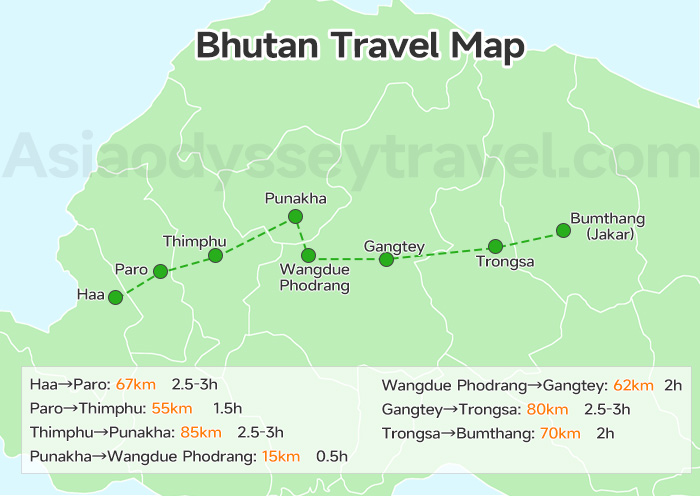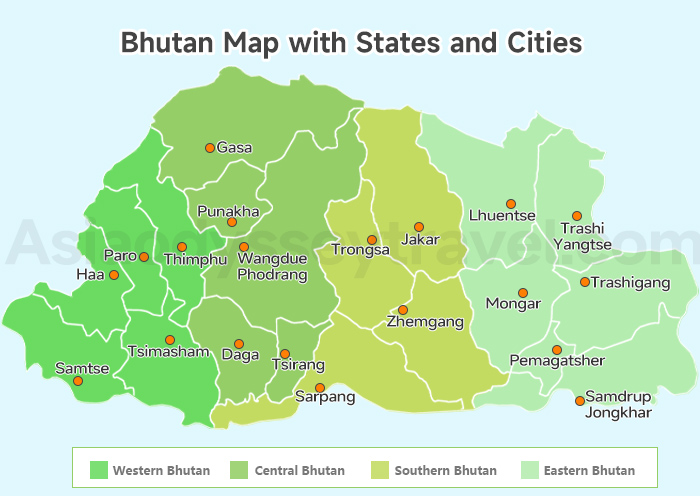Map of Famous Temples in Bhutan
Below is a map showing the locations of Bhutan’s most famous temples (Lhakhangs) featured in this article — from the cliffside wonder of Tiger’s Nest in Paro to the quiet charm of Gangtey Monastery in Phobjikha Valley.
Note: This map only highlights Bhutan’s major temples. If you’re also interested in visiting the country’s iconic dzongs (fortress-monasteries), such as Punakha Dzong or Trongsa Dzong, be sure to check out our separate guide: Bhutan Famous Dzongs – A Fortress Journey Through the Himalayas

Tip: Temples (Lhakhangs) are usually smaller and more intimate than dzongs, offering travelers a closer glimpse into Bhutanese spiritual life. Check more Maps of Bhutan in Bhutan Tourist Maps.
No.1 Tiger’s Nest Monastery (Paro Taktsang) – The Iconic Cliffside Wonder
- Chinese Name: 虎穴寺
- Location: Paro Valley, 12KM from Paro city.
- Altitude: 3,120 meters (10,236 feet)
- Opening Time: 8:00 AM to 5:00 PM
- Recommend Visiting Time:1-2 hours for the monastery and one day for the round-trip Hiking tour.
If you only visit one temple in Bhutan, make it Tiger’s Nest Monastery — locally known as Paro Taktsang. Clinging dramatically to a cliff face 900 meters above the Paro Valley, this sacred site is not just Bhutan’s most famous attraction, but a true spiritual pilgrimage for locals and travelers alike.
Legend says that Guru Rinpoche, the man who brought Buddhism to Bhutan, flew here on the back of a tigress and meditated in a cave — now enshrined within the temple. The current structure was built in 1692 and has become a symbol of Bhutan’s deep spiritual roots.
Getting there is an adventure in itself. The uphill hike through pine forests takes about 2–3 hours one way, with stunning viewpoints and prayer flags along the way. If hiking sounds tough, you can ride a horse part of the way (up to the halfway teahouse).
At the top, you’ll be rewarded with sweeping views of Paro Valley and the chance to experience Bhutan’s spirituality firsthand. Just remember: no photos inside the temple, and dress respectfully — long sleeves, covered legs, and shoes off at the entrance.


No.2 Kyichu Lhakhang (Paro) – One of the Oldest Temples in Bhutan
- Chinese Name: 祈楚拉康
- Location: Paro Valley, 7KM from Paro airport.
- Altitude: 2,280 meters (7,480 feet)
- Opening Time: 9:00 AM to 5:00 PM
- Recommend Visiting Time:1-2 hours
Just a short drive from Paro town, Kyichu Lhakhang is one of Bhutan’s oldest temples — and one of the most sacred. Built in the 7th century by Tibetan King Songtsen Gampo, it’s said to be one of 108 temples constructed across the Himalayas to subdue an evil demoness who was blocking the spread of Buddhism.
Although modest in size, the temple radiates peace. You’ll find colorful prayer flags fluttering in the breeze, spinning prayer wheels, and locals offering butter lamps and prayers. The temple’s interiors are filled with ancient murals, statues, and spiritual energy that give a sense of timeless devotion.
One of the temple’s most unique features? A magical orange tree in the courtyard that bears fruit all year round — a symbol of eternal blessings. Locals believe eating one of its oranges brings good luck.
Tip: Visit in the quiet morning hours to enjoy the serene atmosphere and observe local pilgrims going about their daily rituals.

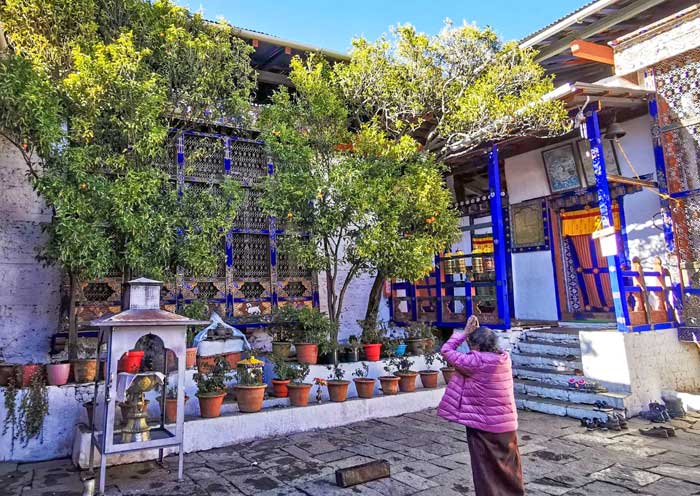
No.3 Chimi Lhakhang (Fertility Temple) – The Quirky & Beloved
- Chinese Name: 切米拉康
- Location: Situated amidst the rice fields of Punakha, near the village of Lobesa,10KM away from the Punakha Dzong.
- Altitude: 1,500 meters (4,921 feet)
- Opening Time: 9:00 AM to 5:00 PM
- Recommend Visiting Time:1 hour
Set in the heart of Punakha’s rice fields, Chimi Lhakhang is one of Bhutan’s most quirky and beloved temples. Known as the “Fertility Temple,” it’s dedicated to Drukpa Kunley, the Divine Madman — a revered Buddhist master famous for his unorthodox ways and humorous teachings.
Getting there is part of the charm. A scenic 20-minute walk through rice paddies and quiet countryside leads you to this hilltop temple. Along the way, you’ll spot houses painted with… yes, colorful phalluses — believed to ward off evil and bring blessings.
Inside the temple, things stay equally playful and sacred. Couples often come here to receive blessings for fertility and happy marriages. A monk may tap your head with a wooden phallus (yes, really!) as part of the “wang” ritual, which locals believe brings good luck and future children.
Tip: It’s a lighthearted place, but also deeply spiritual. Don’t be shy — embrace the local humor and enjoy the unique experience!

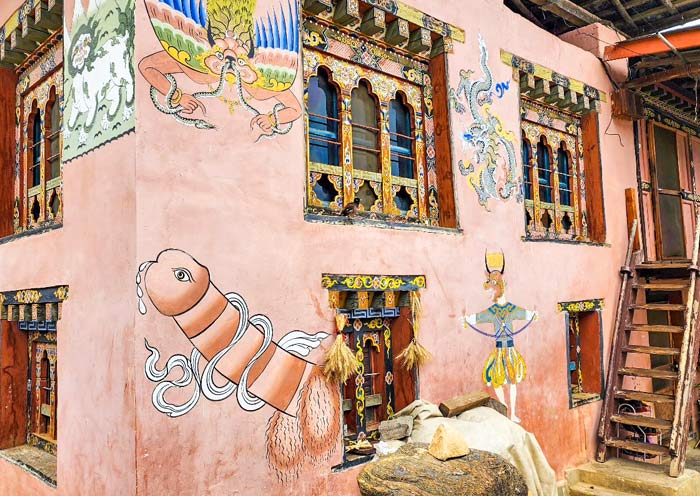
No.4 Gangtey Monastery (Phobjikha Valley) – Spiritual Heart of the Black-Necked Cranes
- Chinese Name: 岗提寺
- Location: Phobjikha Valley in the Wangdue Phodrang
- Altitude: 3,000 meters (9,842 feet)
- Opening Time: 9:00 AM to 5:00 PM
- Recommend Visiting Time:1-3 hours
If Bhutan had a “best kept secret,” it might just be Gangtey Monastery. Tucked away in the peaceful, glacial Phobjikha Valley, this 17th-century monastery feels like it belongs in a dream — quiet, misty, and absolutely breathtaking.
Gangtey isn’t just another pretty temple — it’s also a spiritual stronghold of the Nyingma school, Bhutan’s oldest Buddhist tradition. But what really steals the show? Black-necked cranes! These elegant migratory birds fly in every winter, landing gracefully in the valley fields. It’s so special, there’s even a Black-Necked Crane Festival each November, complete with dances, music, and a crane mascot or two.
Want to stretch your legs? Surrounding the monastery are scenic hiking trails, winding through peaceful countryside, pine forests, and tiny villages. Whether you come for the views, the birds, or the sacred energy, Gangtey is a place where time slows down — and your soul gets a little recharge.
Tips: Don’t forget to bring a jacket — it’s crisp up here, especially in the mornings!


No.5 Tachog Lhakhang (Paro)– A Temple, a Chain Bridge, and a Bit of Magic
- Chinese Name: 唐邱拉康
- Location: Located along the Paro-Thimphu highway, 18km from Paro and 35km from Thimphu.
- Altitude: 2,200 meters (7,218 feet)
- Opening Time: During daylight hours
- Recommend Visiting Time:1 hour
Imagine walking across a swaying iron chain bridge above a glistening river, surrounded by mountains — and on the other side? A quiet little temple that looks straight out of a fairy tale. Welcome to Tachog Lhakhang.
This hidden gem was built in the 15th century by Bhutan’s Iron Man — the legendary Thangtong Gyalpo, an engineer-saint who built dozens of iron bridges across the Himalayas. The bridge to Tachog is one of the last of its kind. Crossing it is a mini adventure — fun, a little wobbly, and completely unforgettable.
The temple itself is small, peaceful, and often surrounded by fluttering prayer flags and the sound of rushing water. It’s not grand like Tiger’s Nest, but it feels incredibly personal — a perfect little stop if you’re traveling between Paro and Thimphu.
Pro tip: Come in the morning for soft light, fewer visitors, and the most magical bridge photos.
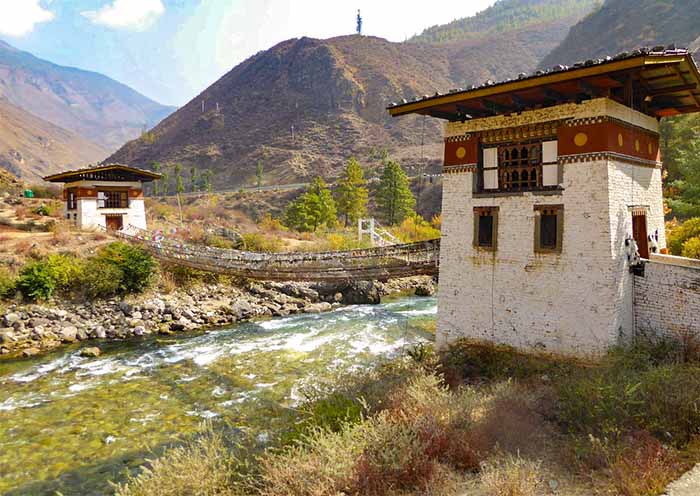
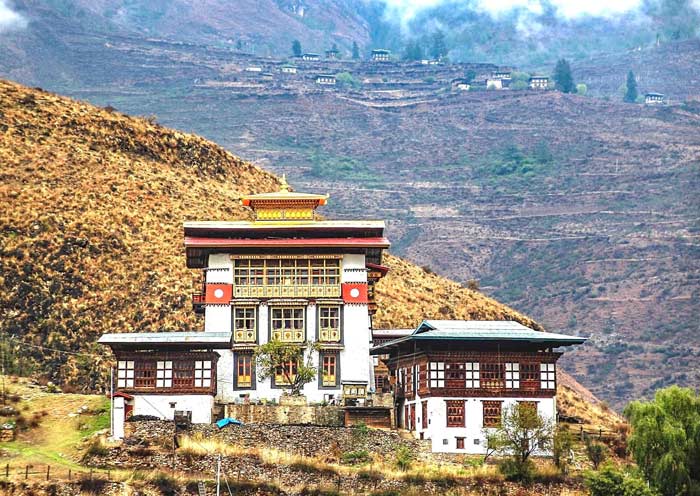
No.6 Karpo Lhakhang & Nagpo Lhakhang (Haa Valley)
- Chinese Name: 白庙和黑庙
- Location: Haa Valley in northwest Bhutan
- Altitude: 2,670 meters (8,760 feet)
- Opening Time: 9:00 AM to 5:00 PM
- Recommend Visiting Time:1-2 hours
Welcome to Haa Valley — one of Bhutan’s most untouched and tranquil corners, where time slows down and the mountains whisper ancient stories. Hidden within this quiet valley are two fascinating temples with a yin-yang vibe: Karpo Lhakhang (White Temple) and Nagpo Lhakhang (Black Temple).
These two temples stand as sacred twins in Bhutanese culture. The White Temple (Karpo), with its clean white walls, symbolizes purity and light. It’s dedicated to Ap Chundu, the valley’s protector deity. Locals often gather here for blessings and festivals — and the peaceful energy is unmistakable.
Just a short distance away, you’ll find the Black Temple (Nagpo). With its darker facade and mysterious aura, it represents strength and protection. It’s said to date back to the 7th century, making it one of Bhutan’s oldest spiritual spots. The temple honors Nagpo Chenpo, a powerful guardian believed to ward off negative forces.
Pro tip: Haa Valley isn’t on most tourist maps, but it should be! These twin temples are perfect for travelers looking for serenity, spiritual depth, and a real sense of discovery.
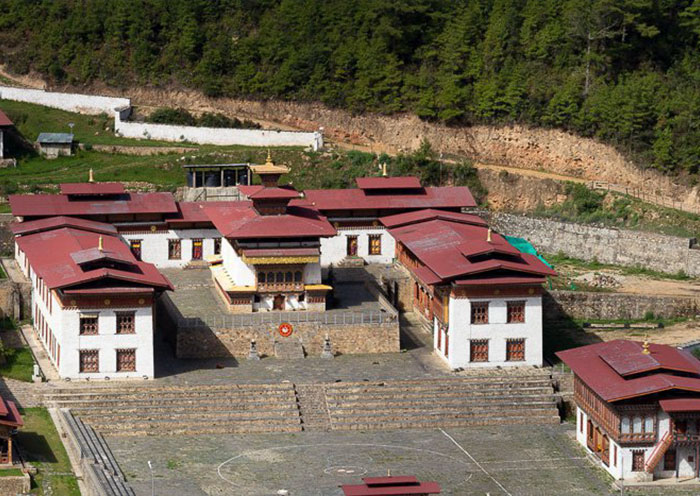

No.7 Kurjey Lhakhang (Bumthang) – The Sacred Heart of Bumthang
- Chinese Name: 古杰寺
- Location: Town of Jakar in Bumthang, 5km from Jakar Dzong
- Altitude: 2,600 meters (8,530 feet)
- Opening Time: 9:00 AM to 5:00 PM
- Recommend Visiting Time:1 hour
Tucked into the lush green folds of Bhutan’s spiritual heartland, Kurjey Lhakhang is more than just a monastery — it’s a pilgrimage site brimming with sacred legends, royal history, and jaw-dropping scenery.
Located in the Choekhor Valley of Bumthang, just a short hop from the peaceful town of Jakar, Kurjey Lhakhang is one of Bhutan’s most sacred temples. Its name means “Body Imprint”, referring to a rock inside the temple believed to bear the imprint of Guru Rinpoche (Padmasambhava), who meditated here in the 8th century after subduing a local demon. Yes — it’s that legendary.
The temple complex consists of three beautiful temples, each representing a chapter of Bhutan’s spiritual and royal journey:
- Guru Lhakhang, the oldest (8th century), marks the meditation cave where Guru Rinpoche left his imprint.
- Sampa Lhundrup Lhakhang, built in the 18th century, houses sacred relics and stunning statues.
- Ka Gon Phur Sum Lhakhang, the newest, was built in the 1990s and symbolizes Guru Rinpoche’s body, speech, and mind.
Fun fact: Kurjey Lhakhang is also the final resting place of the first three Bhutanese kings — so yes, you’re standing in the presence of deep royal and spiritual history.
Don’t Miss: If you’re visiting in late June, try to catch the Kurjey Tsechu, an annual festival full of vibrant mask dances, chanting, and community celebration — a real slice of Bhutanese culture in motion.


No.8 Jambay Lhakhang (Bumthang) – Birthplace of Bhutan’s Spiritual Legacy
- Chinese Name: 简培寺
- Location: Town of Jakar in Bumthang, 4km from Jakar Dzong, 1km from Kurjey Lhakhang
- Altitude: 2,600 meters (8,530 feet)
- Opening Time: 9:00 AM to 5:00 PM
- Recommend Visiting Time:1 hour
If Bhutan had a cradle of Buddhism, Jambay Lhakhang would be it. Set in the spiritual heart of Bumthang, this ancient temple is not just one of the country’s oldest — it’s one of the most legendary.
Built in the 7th century by Tibetan King Songtsen Gampo, Jambay Lhakhang is said to be one of 108 temples built in a single day across the Himalayas to pin down a demoness whose body was believed to be blocking the spread of Buddhism. This one? It’s said to rest on her left knee. Yes, the myths run deep here.
Despite its age, Jambay Lhakhang remains beautifully preserved. Its traditional Bhutanese design, with carved wooden beams and vibrant murals, makes it a favorite among architecture lovers and spiritual seekers alike. Inside, you’ll find sacred statues, including a Maitreya Buddha (the future Buddha) and Guru Rinpoche, adding even more spiritual weight to the visit.
Don’t Miss: Time your visit for October, and you’ll catch the dazzling Jambay Lhakhang Drup festival. It’s a lively celebration packed with masked dances, rituals, and yes — the famous “fire blessing” ceremony where brave souls run under a flaming arch for purification and good luck.


No.9 Changangkha Lhakhang (Thimphu)
- Chinese Name: 昌冈拉康
- Location: Thimphu, on a ridge overlooking Thimphu Valley, 3km from Tashichho Dzong
- Altitude: 2,400 meters (7,874 feet)
- Opening Time: 9:00 AM to 5:00 PM
- Recommend Visiting Time:1 hour
Looking down from a hill above the capital city, Changangkha Lhakhang is one of Thimphu’s oldest and most beloved temples. Built in the 12th century, it’s dedicated to Avalokiteshvara (Chenrezig) — the Bodhisattva of Compassion — and serves as a spiritual anchor for the valley.
But this isn’t just another pretty temple. For local families, Changangkha is the first stop for newborns. Parents bring their babies here to be blessed by the temple's resident lama — and to receive their names, chosen according to Bhutanese astrology. So, if you see a few babies being cradled in their finest, now you know why!
The temple has a calm, contemplative vibe. It’s common to find locals quietly spinning prayer wheels, lighting butter lamps, or whispering mantras. And the view from the ridge? Stunning. You can see all of Thimphu spread out below, framed by mountains.
Travel Tip: Come in the morning for softer light and fewer visitors — and don’t forget to take your shoes off before entering the inner sanctum.

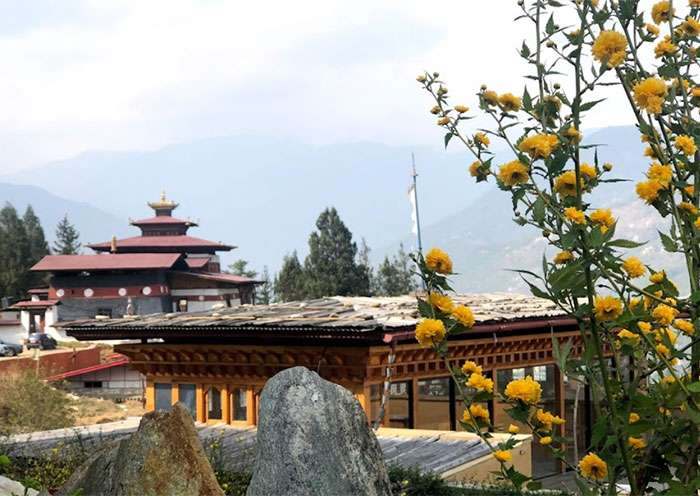
No.10 Tango Monastery & Cheri Monastery: Trekking to the Deep Forest
- Chinese Name: 丹戈寺 切里寺
- Location: Northern Thimphu, 16km from Tashichho Dzong
- Altitude: 2,800 meters (9,186 feet)
- Opening Time: 9:00 AM to 5:00 PM
- Recommend Visiting Time:1-2 hours for the temples, and 6-7 hours for a round-trip trekking.
If you’re craving a bit of adventure wrapped in silence and spirituality, Tango and Cheri Monasteries offer one of the most rewarding day hikes around Thimphu. Nestled deep in the lush hills north of the capital, these two monasteries feel like a hidden world — peaceful, sacred, and surrounded by birdsong and rustling pine trees.
Tango Monastery, founded in the 13th century, is Bhutan’s top institute for Buddhist studies. Its white-washed walls and golden roof shimmer beautifully against the forested slopes. While it’s a place of serious monastic life, visitors are welcome to admire the views and soak in the calm.
Nearby is Cheri Monastery (also known as Chagri Dorjeden Monastery), a historic temple established in 1620 by Zhabdrung Ngawang Namgyal, the father of Bhutan as a nation. It’s an important retreat center for monks and holds deep spiritual importance for Bhutanese Buddhists.
The trek itself? A gentle but steady uphill walk, about an hour or so each way — manageable for most, and absolutely worth the effort. The forest is serene, the air is crisp, and prayer flags flutter overhead like whispers of peace.

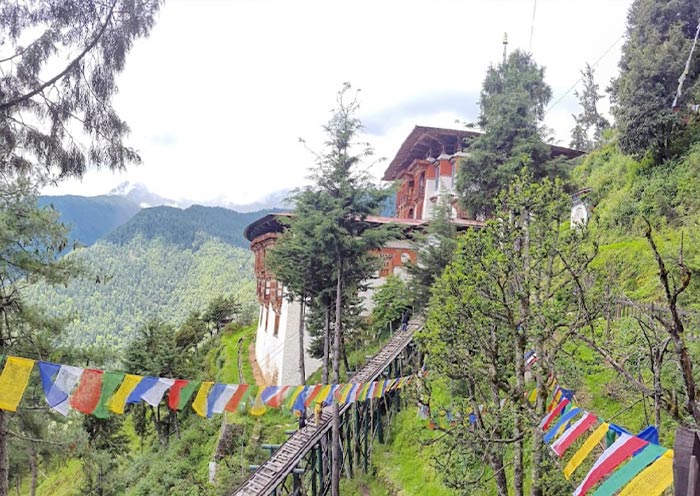
Explore Bhutan with Local-based Asia Odyssey Travel
Asia Odyssey Travel is a local-based travel agency that offers Bhutan Group Tours and customized tours in Bhutan. Our team of experienced local guides ensures that you have an immersive and insightful journey, sharing our deep understanding of Bhutanese culture, history, and spirituality.
Bhutan, known as the "Land of the Thunder Dragon," is a captivating destination with its stunning landscapes, ancient monasteries, and rich Buddhist traditions. Asia Odyssey Travel can help you discover the highlights of Bhutan, including Paro, Punakha, Thimphu, Bumthang, and Gangtey.
Whether you're interested in trekking through pristine mountain trails, participating in vibrant festivals, or exploring remote villages, Asia Odyssey Travel can tailor Bhutan Trekking Tour and Bhutan Festival Tour itineraries to suit your preferences.
Embark on a memorable journey through Bhutan with Asia Odyssey Travel and immerse yourself in the enchanting beauty and traditions of this unique Himalayan kingdom.



